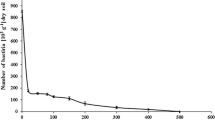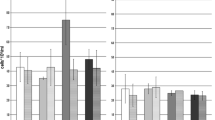Abstract
Purpose
The aims of this study were to isolate an alkaliphilic humus-reducing bacterium, investigate the fastest microbial reduction of humus analog as affected by different cultivation, and examine its ability for iron(III) oxide reduction and organochlorine pollutants (OCPs) degradation.
Materials and methods
A strain of pure culture, designated as HN01, was isolated from cassava dreg compost using anaerobic enrichment procedure with glucose as the electron donor and anthraquinone-2,6-disulphonate (AQDS) as the sole terminal electron acceptor. The isolate strain was identified using phenotypic and phylogenetic analysis. Iron(III) oxides and OCPs were chosen as potential electron acceptors. Strict anaerobic techniques and sterile conditions were applied throughout the incubation experiments, purged with O2-free N2 for 15 min. The concentration of reduced AQDS and Fe(II) was then quantified using a UV–vis spectrophotometer. The concentration of OCPs was analyzed by gas chromatography with a micro-electron capture detector. Cell number was determined by direct plate counting on aerobic Luria–Bertani medium agar medium at pH 9.
Results and discussion
(1) Strain HN01 was identified as Kocuria rosea, and the AQDS reduction by HN01 was observed in NaCl concentrations below 12 % (w/v) (optimum, 10 %) and pH ranges of 6.0–10.0 (optimum, 9.0) with sucrose as electron donor at 30 °C; (2) glucose, sucrose, methanol, ethanol, glycerol, and acetate were the favorable electron donors for AQDS reduction by strain HN01; (3) the strain had the ability of reducing iron(III) oxides in the presence of sucrose at pH 9.0 and its Fe(III)-reducing capacity ranked as goethite (α-FeOOH) > lepidocrocite (γ-FeOOH) > haematite(α-Fe2O3); and (4) the strain could effectively dechlorinate p,p′-DDT (1,1,1-trichloro-2,2-bis(4-chlorophenyl) ethane), and the dechlorination rate reached 71.3 %.
Conclusions
This is the first report of a strain of K. rosea capable of reducing AQDS, iron (III) oxides, and p,p′-DDT, which extends the diversity of the alkaliphilic and halotolerant humus/Fe(III)-reducing bacterium associated with dechlorination. The strain may have the potential to be used for bioremediation of an anoxic alkaline wastewater or site contaminated with OCPs.







Similar content being viewed by others
References
Bala M, Kaur C, Kaur I, Khan F, Mayilraj S (2012) Kocuria sediminis sp. nov., isolated from a marine sediment sample. Antonie van Leeuwenhoek 101:469–478
Bhushan B, Halasz A, Hawari J (2006) Effect of iron(III), humic acids and anthraquinone-2,6-disulfonate on biodegradation of cyclic nitramines by Clostridium sp. EDB2. J Appl Microbiol 100:555–563
Buchanan RE, Gibbons NE (eds) (1974) Bergey's manual of determinative bacteriology. Eighth edition. Williams and Wilkins, Baltimore
Cao F, Li FB, Liu TX, Huang DY, Wu CY, Feng CH, Li XM (2010) Effect of Aeromonas hydrophila on reductive dechlorination of DDTs by zero-valent Iron. J Agric Food Chem 58:12366–12372
Cao F, Liu TX, Wu CY, Li FB, Li XM, Yu HY, Tong H, Chen MJ (2012) Enhanced biotransformation of DDTs by an iron- and humic-reducing bacteria Aeromonas hydrophila HS01 upon addition of goethite and AQDS. J Agric Food Chem 60:11238–44
Coello N, Vidal L (2002) Kocuria rosea as a new feather degrading degrading bacteria. Appl Microbiol 2:165–175
Gorlenko V, Tsapin A, Namsaraev Z, Teal T, Tourova T, Engler D, Mielke R, Nealson K (2004) Anaerobranca californiensis sp. nov., an anaerobic, alkalithermophilic, fermentative bacterium isolated from a hot spring on Mono Lake. Int J Syst Evol Microbiol 54:739–743
Gralnick JA, Newman DK (2007) Extracellular respiration. Mol Microbiol 65:1–11
Hernandez ME, Newman DK (2001) Extracellular electron transfer. Cell Mol Life Sci 58:1562–1571
Hobbiea SN, Li XZ, Basena M, Stingl U, Brune A (2012) Humic substance-mediated Fe(III) reduction by a fermenting Bacillus strain from the alkaline gut of a humus-feeding scarab beetle larva. Syst Appl Microbiol 35:226–232
Hong YG, Gou J, Xu ZC, Xu MY, Sun GP (2007) Humic substances act as electron acceptor and redox mediator for microbial dissimilatory azoreduction by Shewanella decolorationis S12. J Microbiol Biotechnol 17:428–437
Jiang J, Kappler A (2008) Kinetics of microbial and chemical reduction of humic substances: implications for electron shuttling. Environ Sci Technol 42:3563–3569
Li WJ, Zhang YQ, Schumann P, Chen HH, Hozzein WN, Tian XP, Xu LH, Jiang CL (2006) Kocuria aegyptia sp. nov., a novel actinobacterium isolated from a saline, alkaline desert soil in Egypt. Int J Syst Evol Microbiol 56:733–737
Li FB, Li XZ, Li XM, Liu TX, Dong J (2007a) Heterogeneous photodegradation of bisphenol A with iron oxides and oxalate in aqueous solution. J Colloid Interf Sci 311:481–490
Li WJ, Xu P, Schumann P, Zhang YQ, Pukall R, Xu LH, Stackebrandt E, Jiang CL (2007b) Georgenia ruanii sp. nov., a novel actinobacterium isolated from forest soil in Yunnan (China) and emended description of the genus Georgenia. Int J Syst Evol Microbiol 57:1424–1428
Li FB, Wang XG, Li YT, Liu CS, Zeng F, Zhang LJ, Hao MD, Ruan HD (2008) Enhancement of the reductive transformation of pentachlorophenol by polycarboxylic acids at the oxide–water interface. J Colloid Interf Sci 321:332–341
Li FB, Li XM, Zhou SG, Zhuang L, Cao F, Huang DY, Xu W, Liu TX, Feng CH (2010) Enhanced reductive dechlorination of DDT in an anaerobic system of dissimilatory iron-reducing bacteria and iron oxide. Environ Pollut 158:1733–1740
Liu DY (2011) Micrococcus and Kocuria. In: Liu DY (ed) Molecular detection of human bacterial pathogens. CRC Press, Boca Raton, pp 111–115
Liu C, Kota S, Zachara JM, Fredrickson JK, Brinkman CK (2001) Kinetic analysis of the bacterial reduction of goethite. Environ Sci Technol 35:2482–2490
Liu CX, Zachara JM, Foster NS, Strickland J (2007) Kinetics of reductive dissolution of hematite by bioreduced anthraquinone-2,6-disulfonate. Environ Sci Technol 41:7730–7735
Lovley DR, Coates JD, Blunt-Harris EL, Phillips EJP, Woodward JC (1996) Humic substances as electron acceptors for microbial respiration. Nature 382:445–448
Lovley DR, Holmes DE, Nevin KP (2004) Dissimilatory Fe(III) and Mn(IV) reduction. Adv Microb Physiol 49:219–286
Ma C, Wang YQ, Zhuang L, Huang DY, Zhou SG, Li FB (2011) Anaerobic degradation of phenanthrene by a newly isolated humus-reducing bacterium, Pseudomonas aeruginosa strain PAH-1. J Soils Sediments 11:923–929
Ma C, Zhuang L, Zhou SG, Yang GQ (2012) Alkaline extracellular reduction: isolation and characterization of an alkaliphilic and halotolent bacterium, Bacillus pseudofirmus MC02. J Appl Microbial 112:883–891
Park EJ, Roh SW, Kim MS, Jung MJ, Shin KS, Bae JW (2010) Kocuria koreensis sp. nov., isolated from fermented seafood. Int J Syst Evol Microbiol 60:140–143
Parshetti G, Kalme S, Saratale G, Govindwar S (2006) Biodegradation of malachite green by Kocuria rosea MTCC 1532. Acta Chim Slov 53:492–498
Parshetti GK, Telke AA, Kalyanib DC, Govindwarb SP (2010) Decolorization and detoxification of sulfonated azo dye methyl orange by Kocuria rosea MTCC 1532. J Hazard Mater 176:503–509
Pollock J, Weber KA, Lack J, Achenbach LA, Mormile MR, Coates JD (2007) Alkaline iron(III) reduction by a novel alkaliphilic, halotolerant, Bacillus sp. isolated from salt flat sediments of soap lake. Appl Microbiol Biotechnol 77:927–934
Reddy GSN, Prakash JSS, Prabahar V, Matsumoto GI, Stackebrandt E, Sisinthy S (2003) Kocuria polaris sp. nov., an orange-pigmented psychrophilic bacterium isolated from an Antarctic cyanobacterial mat sample. Int J Syst Evol Microbiol 53:183–187
Roden EE, Zachara JM (1996) Microbial reduction of crystalline iron(III) oxides: influence of oxide surface area and potential for cell growth. Environ Sci Technol 30:1618–1628
Roden EE, Kappler A, Bauer I, Jiang J, Paul A, Stoesser R, Konishi H, Xu HF (2010) Extracellular electron transfer through microbial reduction of solid-phase humic substances. Nature Geosci 3:417–421
Rodrigues da Silva ME, Firmino PI, Dos Santos AB (2012) Impact of the redox mediator sodium anthraquinone-2,6-disulphonate (AQDS) on the reductive decolourisation of the azo dye Reactive Red 2 (RR2) in one- and two-stage anaerobic systems. Bioresour Technol 121:1–7
Scott DT, Mckinght DM, Blunt-Harris EL, Kolesar SE, Lovley DR (1998) Quinone moieties act as electron acceptors in the reduction of humic substances by humics-reducing microorganisms. Environ Sci Technol 32:2984–2989
Stackebrandt E, Koch C, Gvozdiak O, Schumann P (1995) Taxonomic dissection of the genus Micrococcus: Kocuria gen. nov., Nesterenkonia gen. nov., Kytococcus gen. nov., Dermacoccus gen. nov., and Micrococcus Cohn 1872 gen. emend. Int J Syst Bacteriol 45:682–692
Stevenson FJ (1994) Humus chemistry: genesis, composition, reactions. Wiley, New York
Tang SK, Wang Y, Lou K, Mao PH, Xu LH, Jiang CL, Kim CJ, Li WJ (2009) Kocuria halotolerans sp. nov., an actinobacterium isolated from a saline soil in China. Int J Syst Evol Microbiol 59:1316–1320
Thompson JD, Gibson TJ, Plewniak F, Jeanmougin F, Higgins DG (1997) The CLUSTAL_X windows interface: flexible strategies for multiple sequence alignment aided by quality analysis tools. Nucleic Acids Res 25:4876–4882
Ulukanli Z, Diğrak M (2002) Alkaliphilic micro-organisms and habitat. Turk J Biol 26:181–191
Wang YB, Wu CY, Wang XJ, Zhou SG (2009) The role of humic substances in the anaerobic reductive dechlorination of 2,4-dichlorophenoxyacetic acid by Comamonas koreensis strain CY01. J Hazard Mater 164:941–947
Wolf M, Kappler A, Jiang J, Meckenstock RU (2009) Effects of humic substances and quinones at low concentrations on ferrihydrite reduction by Geobacter metallireducens. Environ Sci Technol 43:5679–5685
Wu CY, Li FB, Zhou SG (2009) Humus respiration and its ecological significance. Acta Ecol Sin 29:1535–1542
Wu CY, Zhuang L, Zhou SG, Li FB, Li XM (2010) Fe(III)-enhanced anaerobic degradation of 2,4-dichlorophenoxyacetic acid by a dissimilatory Fe(III)-reducing bacterium Comamonas koreensis CY01. FEMS Microb Ecol 71:106–113
Wu CY, Zhuang L, Zhou SG, Li FB (2011) Corneybacterium humicreducens sp. nov., a alkaliphilic humic-reducing bacterium isolated from a microbial fuel cell. Inter J Syst Evol Microbiol 61:882–887
Wu CY, Zhuang L, Zhou SG, Yuan Y, Yuan T, Li FB (2012) Humic substance-mediated reduction of iron(III) oxides and degradation of 2,4-D by an alkaliphilic bacterium, Corynebacterium humireducens MFC-5. Microb Biotech 6:141–149
Ye Q, Roh Y, Carroll SL, Blair B, Zhou J, Zhang CL, Fields MW (2004) Alkaline anaerobic respiration: isolation and characterization of a novel alkaliphilic and meal-reducing bacterium. Appl Environ Microbiol 70:5595–5602
Zhilina TN, Zavarzina DG, Kolganova TV, Lysenko AM, Tourova TP (2009a) Alkaliphilus peptidofermentans sp. nov., a now alkaliphilic bacterial soda lake isolate capable of peptide fermentation and Fe(III) reduction. Microbiology 78:445–454
Zhilina TN, Zavarzina DG, Osipov GA, Kostrikina NA, Tourova TP (2009b) Natronincola ferrireducens sp. nov., and Natronincola peptidovorans sp. nov., new anaerobic alkaliphilic peptolytic iron-reducing bacteria isolated from soda lakes. Microbiology 78:455–467
Zhou GL, Luo XS, Tang YL, Zhang L, Yang Q, Qiu YJ, Fang CX (2008) Kocuria flava sp. nov. and Kocuria turfanensis sp. nov., airborne actinobacteria isolated from Xinjiang, China. Int J Syst Evol Microbiol 58:1304–1307
Acknowledgments
The authors thank the National Natural Science Foundations of China (no. 41101477, 21007091) and the Fundamental Research Funds for Environment and Plant Protection Institute, CATAS (no. 2011Hzs1J006, 2010hzsZDZX001) for financial support for this study.
Author information
Authors and Affiliations
Corresponding author
Additional information
Responsible editor: Jizheng He
Chun-Yuan Wu and Nan Chen contributed equally to this work.
Rights and permissions
About this article
Cite this article
Wu, CY., Chen, N., Li, H. et al. Kocuria rosea HN01, a newly alkaliphilic humus-reducing bacterium isolated from cassava dreg compost. J Soils Sediments 14, 423–431 (2014). https://doi.org/10.1007/s11368-013-0679-1
Received:
Accepted:
Published:
Issue Date:
DOI: https://doi.org/10.1007/s11368-013-0679-1




